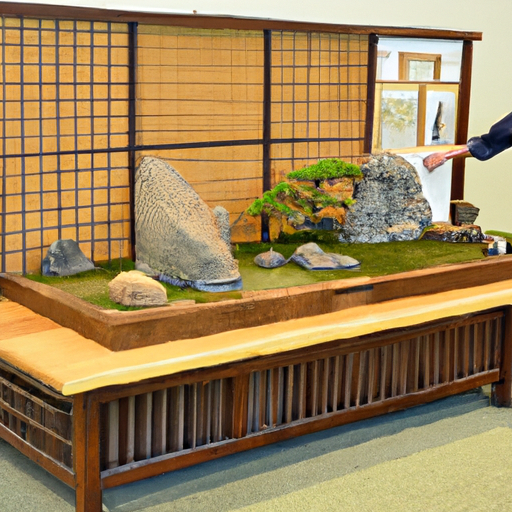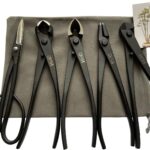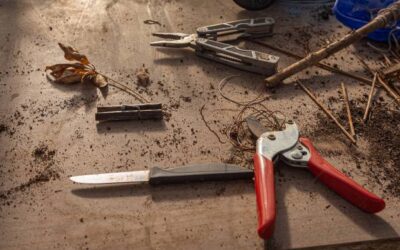In this article, you will learn about the importance of preserving your Japanese garden tools and some tips on how to properly maintain them. Taking care of these tools is crucial as they can be quite expensive to replace, and improper maintenance can lead to rust and deterioration. By following these care tips, you’ll be able to extend the lifespan of your Japanese garden tools and enjoy their beauty and functionality for years to come.
Firstly, it’s essential to clean your Japanese garden tools after every use. Use a soft brush or cloth to remove dirt and debris from the blades and handles. Avoid using harsh chemicals or abrasive materials that can damage the tools. After cleaning, make sure to dry them thoroughly to prevent rust formation. Secondly, regular oiling is necessary to keep your tools in good condition. Apply a light coat of oil, such as camellia oil or vegetable oil, to the metal parts and handles to provide protection against moisture and rust. Lastly, store your tools in a dry and well-ventilated area to prevent humidity and temperature variations. Consider hanging them or using a tool rack to keep them organized and easily accessible. By following these maintenance and care tips, your Japanese garden tools will not only remain in excellent condition but also continue to enhance the beauty of your garden.
Why is preservation important?
Taking care of your Japanese garden tools is essential to ensure their longevity and functionality. By preserving them properly, you can extend their lifespan, maintain their functionality, and preserve their aesthetic appeal.
Extend the lifespan of your tools
Taking the time to preserve your Japanese garden tools will significantly extend their lifespan. These tools are often made with traditional craftsmanship using high-quality materials, which means they can last for many years if properly cared for.
By regularly cleaning, oiling, and avoiding rust and corrosion, you can prevent premature wear and tear. This will save you money in the long run, as you won’t need to constantly replace your tools.
Maintain their functionality
Preserving your Japanese garden tools is not just about keeping them looking nice. It’s also about ensuring they perform their intended functions effectively.
Regularly sharpening the blades of your tools, oiling the moving parts, and maintaining the wooden handles will ensure they function at their best. This will make your gardening tasks easier and more efficient.
Preserve their aesthetic appeal
Japanese garden tools are not only functional but also visually appealing. The craftsmanship and detail put into these tools make them works of art in their own right.
By preserving your tools, you are not only maintaining their functionality but also preserving their aesthetic beauty. Whether it’s the intricate carvings on the handles or the polished metal surfaces, proper care will keep your tools looking stunning for years to come.
Understanding the materials
To properly care for your Japanese garden tools, it’s essential to understand the materials they are made from. Here are some key points to consider:
Different types of metals used
Japanese garden tools are often made from high-quality metals such as carbon steel or stainless steel. These metals are known for their durability and sharpness.
Carbon steel blades are known for their exceptional sharpness but are prone to rust if not properly cared for. Stainless steel, on the other hand, is more resistant to corrosion but might not be as sharp.
Knowing the type of metal your tools are made from will help you tailor your maintenance routine accordingly.
Identifying the handles and grips
The handles and grips of Japanese garden tools are typically made from wood or bamboo. These natural materials add beauty and functionality to the tools.
Wooden handles should be smooth and free from cracks or splinters. Bamboo handles are known for their flexibility and strength.
By identifying the type of handle or grip your tool has, you can provide the appropriate care and maintenance required to keep them in top shape.
Caring for the wooden components
Wooden components, such as handles and sheaths, require special care to prevent rot and damage. Here are some tips to help you maintain wooden parts:
- Regularly clean the wooden components with a soft cloth to remove dirt and debris.
- Avoid using harsh chemicals or abrasive cleaners that can strip the wood’s natural oils.
- Apply a thin layer of wood preservative or oil to protect the wood and prevent it from drying out.
- Repair any cracks or chips in the wood using wood glue or epoxy.
By properly caring for the wooden components, you can prolong their lifespan and ensure the overall longevity of your Japanese garden tools.

Cleaning your tools
Regular cleaning is an essential part of maintaining your Japanese garden tools. It helps to remove dirt, debris, and harmful substances that can compromise the functionality and appearance of your tools.
Removing dirt and debris
After each use, make it a habit to remove dirt and debris from your tools. You can use a stiff brush or a cloth to wipe away any buildup. Pay extra attention to hard-to-reach areas and crevices where dirt can accumulate.
Avoiding harsh chemicals
When cleaning your Japanese garden tools, avoid using harsh chemicals or abrasive cleaners. These can damage the metal surfaces, remove protective coatings, and deteriorate wooden components.
Instead, opt for mild soap and water solutions or specialized tool cleaning solutions designed for gardening equipment. These will effectively clean your tools without causing damage.
Drying techniques
After cleaning your tools, make sure to thoroughly dry them to prevent moisture buildup and rust formation. Use a clean cloth to wipe away any excess water and allow the tools to air dry completely before storing them.
For hard-to-reach areas, you can use a hairdryer on a low heat setting to ensure all moisture is removed. Just make sure not to overheat the metal, as this can cause damage.
Preventing rust and corrosion
Rust and corrosion are common issues that can affect the longevity and functionality of your Japanese garden tools. By taking preventative measures, you can avoid these problems and keep your tools in top condition.
Using rust inhibitors
To protect your tools from rust, it’s advisable to use rust inhibitors. These products create a protective barrier on the metal surfaces, preventing moisture from coming into contact with the metal.
You can find rust inhibitors in the form of sprays, liquids, or waxes. Just make sure to follow the manufacturer’s instructions for proper application.
Storing the tools correctly
Proper storage is crucial for preventing rust and corrosion. Make sure to store your Japanese garden tools in a dry and well-ventilated area. Avoid storing them in damp spaces or areas prone to high humidity.
Consider using tool racks or hooks to hang your tools, keeping them off the ground and away from moisture. This will help to promote airflow and prevent moisture buildup.
Avoiding moisture accumulation
Moisture accumulation is one of the leading causes of rust and corrosion. To prevent this, make sure your tools are completely dry before storing them. If you notice any signs of moisture, wipe the tools down and allow them to air dry before putting them away.
You can also consider using desiccant packs or moisture-absorbing materials in your tool storage area to further prevent moisture accumulation.

Sharpening the blades
Sharp blades are essential for effective gardening. Regularly sharpening the blades of your Japanese garden tools will ensure they perform their best and make your gardening tasks easier.
Choosing the right sharpening tools
When it comes to sharpening Japanese garden tool blades, it’s important to choose the right tools. Consider investing in high-quality sharpening stones or tools specifically designed for sharpening Japanese gardening tools.
Different tools require different sharpening techniques, so make sure to follow the manufacturer’s instructions or seek guidance from a professional if you’re unsure.
Maintaining the correct angle
Maintaining the correct sharpening angle is crucial to ensure your tools remain sharp and effective. For most Japanese garden tools, a sharpening angle between 15 and 20 degrees is recommended.
Use a honing guide or visual aids provided with the sharpening tool to help you maintain the correct angle. Taking your time and gradually working on the blade will yield the best results.
Testing the sharpness
After sharpening your Japanese garden tool blades, it’s essential to test their sharpness. You can do this by gently running your finger along the edge or cutting through a piece of paper.
If the blade easily cuts through the paper or feels razor-sharp, you’ve successfully sharpened it. If not, continue sharpening until you achieve the desired sharpness.
Oiling and lubricating
Applying oil and lubricant to your Japanese garden tools is an essential step in their maintenance routine. Oiling and lubricating prevent rust, protect the metal surfaces, and keep the moving parts functioning smoothly.
Importance of regular oiling
Regular oiling is crucial for preventing rust and prolonging the lifespan of your tools. It creates a protective barrier on the metal surfaces, preventing moisture from coming into contact with the metal.
Make it a habit to oil your tools after cleaning and drying them. This will ensure they remain protected even during storage.
Selecting suitable oil
When it comes to selecting oil for your Japanese garden tools, it’s important to choose a suitable option. Many gardening tool manufacturers recommend using camellia oil or mineral oil for this purpose.
Avoid using cooking oils or petroleum-based products, as these can cause damage to the metal surfaces or wooden components.
Lubricating moving parts
In addition to oiling the metal surfaces, lubricating the moving parts of your Japanese garden tools is equally important. This includes pivot points, springs, and hinges.
Apply a small amount of lubricant to these areas to keep the parts moving smoothly and prevent any sticking or seizing. Be sure to wipe away any excess lubricant to avoid attracting dirt and debris.
Maintaining wooden handles
Wooden handles are an integral part of many Japanese garden tools. Proper care and maintenance of these handles will ensure their longevity and functionality.
Applying wood preservatives
Wood preservatives are essential for maintaining the integrity of wooden handles. These products help to prevent rot, cracking, and warping.
Apply a thin layer of wood preservative or oil to the handles, following the manufacturer’s instructions. This will help to seal the wood and protect it from moisture damage.
Repairing cracks and chips
If you notice any cracks or chips in your wooden handles, it’s important to address them promptly. Cracks and chips can weaken the handles and make the tools less effective.
Use wood glue or epoxy to repair any damaged areas. Apply the adhesive according to the product instructions and allow it to dry completely before using the tool again.
Preventing wood rot
Wood rot can occur if wooden handles are exposed to excessive moisture or damp conditions. To prevent this, make sure to store your tools in a dry, well-ventilated area.
Regularly inspect the handles for any signs of rot, such as soft or discolored wood. If you notice any issues, remove the affected handle and replace it with a new one to avoid compromising the tool’s functionality.
Storing your tools
Properly storing your Japanese garden tools is essential for their preservation. By following these tips, you can ensure your tools remain in top condition when not in use.
Safe storage options
When storing your tools, make sure to choose a safe and secure location. Consider using a dedicated tool shed or cabinet to protect them from the elements and potential damage.
Avoid storing your tools in areas with fluctuating temperatures, excessive humidity, or direct sunlight, as these conditions can cause damage. Keeping your tools in a controlled environment will help to extend their lifespan.
Organizing your tool shed
Organizing your tool shed or storage area is essential for easy access and preventing damage. Consider using hooks, racks, or pegboards to hang your tools, keeping them off the floor and reducing the risk of moisture buildup.
Labeling or grouping similar tools together can also help you quickly find what you need and minimize the chances of misplacing or damaging your tools.
Protective cases and covers
To provide an extra layer of protection for your Japanese garden tools, consider using protective cases or covers. These can help to prevent dust, dirt, and potential impact damage when the tools are not in use.
Choose durable and breathable materials that will not trap moisture, as this can lead to rust or corrosion.
Regular maintenance schedule
Creating a regular maintenance schedule for your Japanese garden tools will ensure you stay on top of their care and prevent any issues from arising. Here are some tips to help you establish a routine:
Setting a routine
Set a specific time every month or season to inspect, clean, and maintain your tools. Consistency is key when it comes to preserving your tools and keeping them in good condition.
Consider marking your maintenance schedule on a calendar or setting reminders on your phone to help you stay organized and accountable.
Creating a checklist
Creating a checklist can be a helpful tool to ensure you cover all the necessary maintenance tasks. List all the steps you need to take, including cleaning, oiling, sharpening, and inspecting for damage.
By following a checklist, you can systematically go through each task without forgetting any important steps.
Tracking maintenance activities
Keep a record of your maintenance activities, including dates of when each task was performed. This will help you track the frequency of maintenance and identify any patterns or issues with specific tools.
Having a documented maintenance history can also be helpful when purchasing new tools or seeking advice from professionals in the future.
Conclusion
By following these maintenance and care tips, you can preserve the longevity and beauty of your Japanese garden tools. Taking the time to clean, oil, and maintain them properly will ensure they continue to serve you well for years to come.
Investing in the care of your tools is an investment in the future of your gardening projects. By enjoying long-lasting tools and preserving the beauty of your garden, you can create a space that brings you joy and tranquility.








